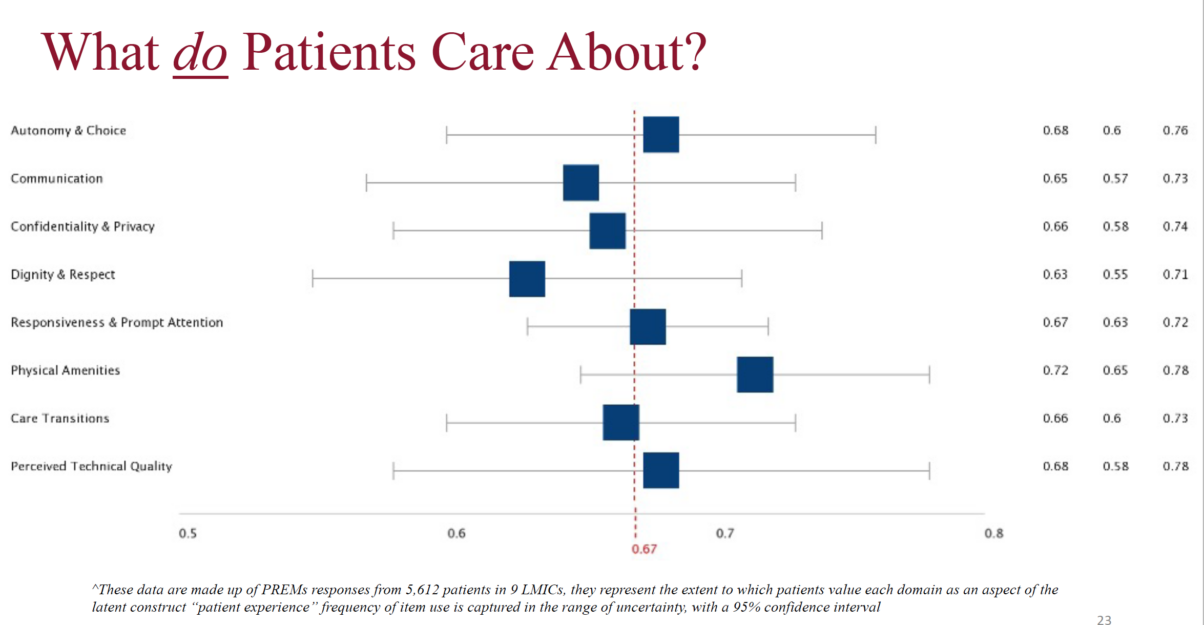Overview
Even as the availability and affordability of healthcare improves, many countries are not experiencing anticipated gains in health outcomes. One potential driver of stagnating health outcomes is the delivery of low-quality health services. While people may have better access to health services, the quality of those services is highly variable. At best, healthcare can improve health and save lives; but it can also cause physical harm and erode trust. Indeed, between 5.7 and 8.4 million deaths are estimated to result from poor-quality healthcare each year in low- and middle-income countries (LMICs).
In line with these findings, quality has recently been recognized as an important area of performance measurement in the field of global health. Indeed, 2018 saw the release of three important reports on quality of care globally. Broadly, these documents define quality as the degree to which health services for individuals and populations are person-centered and increase the likelihood of desired health outcomes. All three reports, while lauding progress made in areas such as maternal and child health and select infectious diseases, make clear that access alone is insufficient to improve health outcomes.
These documents define quality as the degree to which health services for individuals and populations are person-centered and increase the likelihood of desired health outcomes.
While quality is multifaceted, in this session we focus on patient-centeredness; a critical element of quality healthcare outlined by all three reports.
Measuring person-centeredness can be a source of confusion; without a keen focus on what to measure, and why to measure it, related indicators often result in a preponderance of data that may be structural or input driven, but not necessarily linked to outcomes or the improvement of care. Thought leaders in the quality and safety fields have argued that patient-centeredness is the most fundamental domain of care quality; and should therefore be treated as an overarching area of concern for any facility or health system performance assessment. However, the domain is also plagued by a conceit that person centeredness is conceptually “soft” and, in turn, not quantifiable. In this session we address these tensions directly: exploring how this domain can be quantified, while also embracing the complexity and issues with existing measurement approaches.
After participating in this session, one should be able to:
- Situate patient-centeredness within the dominant quality of care frameworks
- Identify similarities and differences in how this domain of quality is defined
- Hypothesize how these definitions relate to different approaches to measuring patient-centeredness
- Understand key tools for assessing patient centeredness, their strengths and weaknesses
- Engage in critical discussion with peers on the clinical implications of how to assess patient-centeredness
The session is designed for clinicians and researchers who care about health and healthcare and wish to learn more about how to measure and improve that care for patients and, ultimately, hold systems accountable to patients through performance measurement.
Suggested Reading
- Berwick, D. M. (2009). What ‘Patient-Centered’ Should Mean: Confessions Of An Extremist. Health Affairs, 28(Supplement 1), w555–w565. https://doi.org/10.1377/hlthaff.28.4.w555
- Larson, E., Sharma, J., Bohren, M. A., & Tunçalp, Ö. (2019). When the patient is the expert: Measuring patient experience and satisfaction with care. Bulletin of the World Health Organization, 97(8), 563–569. https://doi.org/10.2471/BLT.18.225201
Optional Reading
- Sando, D., Ratcliffe, H., McDonald, K., Spiegelman, D., Lyatuu, G., Mwanyika-Sando, M., Emil, F., Wegner, M. N., Chalamilla, G., & Langer, A. (2016). The prevalence of disrespect and abuse during facility-based childbirth in urban Tanzania. BMC Pregnancy and Childbirth, 16(1), 236. https://doi.org/10.1186/s12884-016-1019-4
Experience This Session
- View presentation slides here: HSA Session 6.
- Watch seminar session here.
